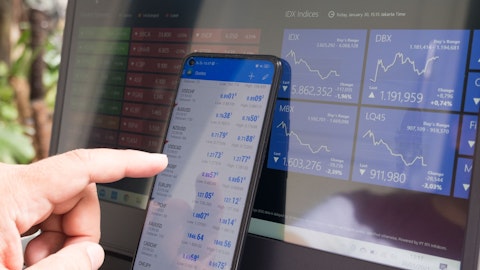Charl Keyter: Thanks, Adrian. Yes. Look, I think in the second half of the year last year, we had those two significant events that I mentioned. So in July, we obviously had the incident at the K4 shaft and we had the fire at Driefontein. So effectively, what it meant for H2 was that we carried the full cost of K4. That restructuring was only completed in December, but essentially carried pretty much the full cost of that shaft for six months without any revenue. And at D5, we carried the full cost for a quarter and then ramped up during the fourth quarter. So production was significantly lower. In total, the impact from each of those, Driefontein fire was just over 900 kilos of gold that we didn’t produce, so basically lost revenue. And at [indiscernible] was also just under a tonne of gold that we lost there. So I think that drives the major discrepancy with those two incidents I referred to earlier in the presentation.
Adrian Hammond: It just seems larger than what you’re saying. But if I can just ask Neal question. Neal, you’re sitting on one of the significant uranium resource. What would it take to monetize that in terms of bringing it to market?
Neal Froneman: Yes, so Adrian and again, Richard, stay online if I can put it that way. Adrian, we’ve been working for some years on how do we monetize the uranium assets that we have. The Cooke dump is a spectacular asset that is the primary reason we actually acquired Cooke, not for the gold business. So we’ve explored many options. It’s been difficult not being able to process the Cooke dam until more recently with DRD having now done. I think in line with protecting the balance sheet and being careful in terms of where we spend money. And what I can say is we’re not going to bring these assets to account using our own balance sheet. Richard has had a lot of inbound calls. We’ve got a couple ideas we can’t really share with you now and we will make a decision over the next probably quarter, two quarters on exactly how we’re going to take that initiative forward to realize value.
It’d be let’s say instantaneous cash. Value for those assets, by doing some smart things. Rich, I don’t know if you want to add to that.
Richard Stewart: Neal, thanks. I think you’ve covered the key aspects. I mean your point on the DRD unlocking it through the deposition, that was always one of the problems of that project. So that’s really been solved for now. Just to add, the Cooke Dam itself is really a co-product project. It’s got a significant amount of gold. So of course, there we’ve got the relationships with DRD. And as Neal says, I think we’ve got several opportunities to look at how we can optimize value with that through that asset. With partnerships, I think some of the other uranium assets are not assets that we would look to develop ourselves, but they certainly may have opportunity within broader strategies and groups. And we are engaging with various parties to explore what could be possible there. So Adrian, is receiving attention, but we have to give more detail in the future. Thanks.
Neal Froneman: If I can just come in quickly, Adrian, and I’ll give you we’ll talk offline on the cash flow issue. But if you look in the book, under the cash flow table, there is an explanation. And the big amount big part of that R10 billion you mentioned is due to intercompany working capital accounts payable. So it’s actually money flowing from the gold operations to the SA PGM operations. It happens every period, and there is an explanation, albeit a bit confusing, underneath the table, but we can cover it offline if you wish. And then just, I just wanted to ask at the SA PGM operations. In 20 or last year, we guided for, all in sustaining cost from the SA PGM operations of 20,800 per ounce to 21,800 per ounce. And this year, it’s 21,800 per ounce to 22,500 per ounce.
So that’s only a 5% and 3% respective increase in costs year-on-year in the in the guidance. And actually, we came in if you look on the front page, the actual all in sustaining costs came in well below the 28,000 bottom of the range that we indicated coming in at 20,054. So, yes, as Richard said, it’s a bit complicated due to byproduct credited movements. Can we take the next call?
Unidentified Analyst: Thank you, operator. Good afternoon, Neal and team. My first question is a follow-up that Adrian asked on the gold operation. Your all in sustaining cost is sitting around $2,000 an ounce. Is there even a possibility to get it closer to $1600 or lower? Because remember two years ago, we were presented with this plan to get the cost down, it seems to be pretty stickier on the 2000. So we can talk to that. Other questions related to battery metals portfolio, one, caliber depending on that delay, how does it impact your CapEx? Second on Sandouville, is there a timeline like tentative timeline on when you make a decision? Because looking at losing $70 million in EBITDA, that was last year. We don’t know what this year is going to look like? And then third on new century, the flooding event last year seems to have repeated this year as well. What steps have the company taken to kind of manage the operations around them? Thank you.
Neal Froneman: Yes. Thanks, Raj, and good morning. So I’m going to ask my Chief Regional Officers to step up and talk about why don’t you start with, Keliber? And to, let’s say, protect the assets against these extreme weather events. Mika, if you wouldn’t mind starting.
Mika Seitovirta: Thank you, Neal, and thanks for the questions. If I start from Sandouville. First of all, we are doing a lot of work in order to reduce the losses at Sandouville, and we can do a lot of things there. So, we are moving forward. However, I want to emphasize that what we have said is that as an outcome from our strategic review, so Sandouville is not going to be profitable enough. So, therefore, we are doing now the feasibility study. The timeline is a good question, but it’s a little bit too early to give you a timeline. I’m absolutely sure that we can give the timeline of, the transition, when the feasibility study and the transition plan are ready, and that’s going to be later on this year. And then we can also say that the transition will take this time and then the ramp up of production provided that it’s as encouraging as the scoping study results have been.




